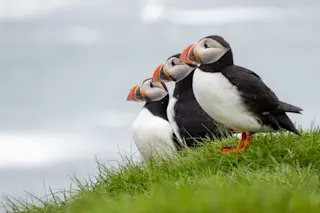If you've ever seen a puffin, with its striking black-and-white feathers and vivid orange beak, you might have wondered: Are puffins penguins? The short answer is no, but the reasons why are as intriguing as these birds themselves.
Puffins are unique creatures with their own fascinating characteristics. Here, we’ll explore what puffins are, where they live, how they hunt and fly, and why they are increasingly vulnerable to environmental threats — all while clearing up the puffin-penguin confusion for good.
(Credit: darkntwistyphotography/Shutterstock)
darkntwistyphotography/Shutterstock
Puffins are small seabirds belonging to the Alcidae family. There are four species of puffins: the Atlantic puffin (Fratercula arctica), the Tufted Puffin (Fratercula cirrhata), the Horned Puffin (Fratercula corniculata), and the Rhinoceros Auklet (Cerorhinca monocerata). These birds are often recognized by their colorful beaks, which become especially vibrant during the breeding season. Despite their small size, puffins are impressive fliers and swimmers, adapted to life on ...














